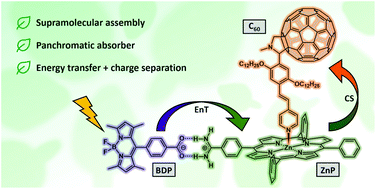Cascades of energy and electron transfer in a panchromatic absorber†
Abstract
The investigation of molecular model systems is fundamental towards a deeper understanding of key photochemical steps in natural photosynthesis. Herein, we report an entirely non-covalent triad consisting of boron dipyrromethene (BDP), porphyrin (ZnP), and fullerene (C60). Non-covalent binding motifs such as an amidinium–carboxylate salt bridge as well as axial pyridyl–metal coordination offer substantial electronic coupling and establish efficient pathways for photoactivated energy and electron transfer processes along a well-tuned gradient. Experimental findings from steady-state and time-resolved spectroscopic assays, as well as (spectro-)electrochemical measurements corroborate the formation of BDP|ZnP|C60 in solution, on one hand, and significant communication in the excited states, on the other hand. BDP acts as an energy harvesting antenna towards ZnP, which eventually undergoes charge separation with C60 by electron transfer from ZnP to C60. Notably, full spectral deconvolution of the transient species was achieved, supporting the successful self-assembly as well as giving a clear view onto the occurring photophysical processes and their spectral footprints upon photoexcitation.



 Please wait while we load your content...
Please wait while we load your content...